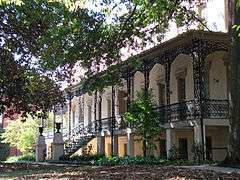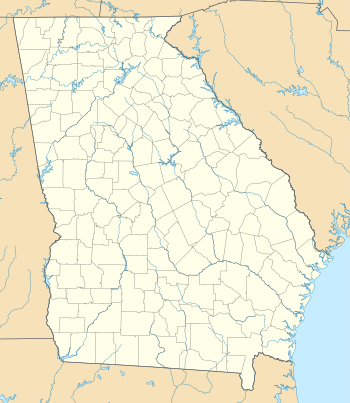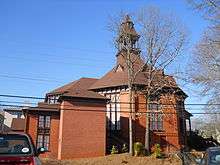Lucy Cobb Institute
| Lucy Cobb Institute | |
|---|---|
| Location | |
|
200 block, North Milledge Avenue Athens, Georgia | |
| Information | |
| Established | 1859 |
| Founder | Thomas R.R. Cobb |
| Closed |
1931 |
|
Lucy Cobb Institute Campus | |
 | |
  | |
| Location | 200 N. Milledge Ave., University of Georgia campus, Athens, Georgia |
| Coordinates | 33°57′22″N 83°23′23″W / 33.95611°N 83.38972°WCoordinates: 33°57′22″N 83°23′23″W / 33.95611°N 83.38972°W |
| Built | 1858 |
| Architect | Thomas, W.W. |
| Architectural style | Early Republic, Octagon Mode, Regency |
| NRHP Reference # | [1] |
| Added to NRHP | March 16, 1972 |
The Lucy Cobb Institute was a girls' school on Milledge Avenue in Athens, Georgia. It was founded by Thomas R.R. Cobb, and named in honor of his daughter, who had died of scarlet fever[2] at age 14,[3] shortly before construction was completed and doors opened;[4] it was incorporated in 1859.[5] The cornerstone for the Seney-Stovall Chapel was laid in May 1882,[6] and the octagonal building was dedicated in 1885.[7] The school closed in 1931.
The campus of the Lucy Cobb Institute was listed on the National Register of Historic Places on March 16, 1972. Today, the Carl Vinson Institute of Government of the University of Georgia is housed in the former Lucy Cobb Institute.
History
Background
In 1854, a piece called "The Education of Our Girls" ran in a local paper, the Athens Watchman.[8] The letter was written by Laura Cobb (Mrs. Williams) Rutherford,[9] who was "writing from a ladylike modesty" about the poor state of education for women in the South.[10] It was signed "Mother" and argued, "girls have the same intellectual constitution as men and have the same right as men to intellectual cultural development".[7] One of the letter's readers was Mrs. Rutherford's brother, Thomas R.R. Cobb, the father of several daughters.[7] Cobb, a lawyer and later a secessionist,[10][11] was completely unaware of the author's identity[8] and after reading the editorial began raising funds for a girls' school.[7] For Cobb, this school would be a place where "orthodox southern moral and racial values could be transmitted to future generations".[11] His association with the school would come to an "abrupt end" in 1861 when one of his daughters quarreled with a teacher, and both Callie and Sallie Cobb were withdrawn.[11]
School opens
The trustees purchased eight acres of land on what is now known as Milledge Avenue.[11] When the school opened on January 10, 1859, its first principal was R. M. Wright.[8][11] (It was in April of this same year the Watkinsville Road acquired its present name of Milledge Avenue.)[12] The school was later headed by Madame Sosnowski (who organized the Home School after leaving the Lucy Cobb Institute).[8]
Mildred Lewis Rutherford, or "Miss Millie", a graduate herself of Lucy Cobb Institute,[13] took over leadership of the school in 1880. The Georgia Writers' Project, in a 1940 publication on the state published in the American Guide Series, characterized her thusly:
'Miss Millie,' always a champion of southern traditions, was a woman of powerful personality, commanding presence, and fearlessly outspoken opinions; she was known widely for the speeches she delivered in hoop skirts. For all her decorum, she seemed to enjoy the protracted battles over the plaster goats that stood at the end of the dormitory's long veranda. The college boys periodically painted these animals in their school colors, red and black. At last they were broken when the boys attempted to hide them; some of the former belles of Lucy Cobb still cherish pieces of the goats as souvenirs.[10]
Seney-Stovall Chapel

It was Miss Millie who decided the girls needed a chapel and had them write seeking funding for one. In 1881, Nellie Stovall wrote "a beautiful and girlish letter"[14] to George I. Seney, who responded with the funding for the $10,000 structure, an octagonal red brick building called the Seney-Stovall Chapel.[4][6] It was designed by a local architect, William Winstead Thomas.[15]
When Miss Millie stepped down from the role of principal in 1895, she was replaced at the school's helm by her sister, Mrs. M.A. Lipscomb.[8] Rutherford and Lipscomb were nieces of T.R.R. Cobb.[14]
The end
Although the institute "became a well-known girls' preparatory school",[2] "praised throughout the South for its emphasis on gentle manners and old-fashioned accomplishments",[10] it "did not survive the depression",[2] and closed its doors in 1931.[6] At that point, the University of Georgia took over its campus, and used the main building as a women's dormitory and eventually storage.[2]
A restoration effort to save the complex was completed in 1997 with the renovation of Seney-Stovall Chapel.[16] The former Lucy Cobb Institute became the home of the Carl Vinson Institute of Government.[6][16]
Notable alumnae
References
- ↑ National Park Service (2009-03-13). "National Register Information System". National Register of Historic Places. National Park Service.
- 1 2 3 4 Boney, F.N. (1989). A Walking Tour of the University of Georgia. University of Georgia Press. pp. 88–89. ISBN 0-8203-1081-6. Retrieved 12 February 2011.
- ↑ Adams, Herbert Baxter (1889). "Miscalleneous Institutions". Education in Georgia. Washington, DC: Government Printing Office. pp. 110–12.
- 1 2 Jones, Charles Edgeworth (1889). Herbert Baxter Adams, ed. Education in Georgia. Contributions to American educational history. 5. pp. 110–112.
- ↑ "Act to incorporate the Lucy Cobb Institute for the education of ladies in the town of Athens". Acts Passed by the General Assembly of Georgia. Retrieved 12 February 2011.
- 1 2 3 4 "Seney-Stovall Chapel History". Carl Vinson Institute of Government, University of Georgia. Retrieved 11 February 2011.
- 1 2 3 4 Marsh, Kenneth Frederick; Marsh, Blanche (1979). Athens: Georgia's Columned City. Atlanta: Cherokee Publishing Company. pp. 58–59. ISBN 0-87797-048-3.
- 1 2 3 4 5 Knight, Lucian Lamar (1913). Georgia's Landmarks Memorials and Legends: Landmarks and memorials. 1. Atlanta: Printed for the author by The Byrd Printing Company, State Printers. pp. 437–438. OCLC 1333051. Retrieved 12 February 2011.
- ↑ Case, Sarah (2009). "Mildred Lewis Rutherford (1851-1928) The redefinition of New South White Womanhood". In Ann Short Chirhart & Betty Wood. Georgia Women: Their Lives and Times. Athens, Georgia: University of Georgia Press. pp. 272–296. ISBN 978-0-8203-3900-9.
- 1 2 3 4 Georgia Writers' Project (1940). Georgia: a Guide to Its Towns and Countryside. University of Georgia Press. p. 155. Retrieved 12 February 2011.
- 1 2 3 4 5 McCash, William B. (2004). Thomas R.R. Cobb (1823–1862): The Making of a Southern Nationalist. Macon, Georgia: Mercer University Press. pp. 101–106. ISBN 0-86554-858-7. Retrieved 12 February 2011.
- ↑ Hynds, Ernest (1974). Antebellum Athens and Clarke County Georgia. Athens, Georgia: University of Georgia Press. p. 48. ISBN 0-8203-0341-0.
- ↑ Rutherford, Mildred Lewis (2000) [1923]. "Life Sketch of Miss Mildred Rutherford". In Unknown. History of Athens & Clarke County, Georgia. Athens, Georgia; Greenville, South Carolina: H.J. Rowe (original), Southern Historical Press, Inc. (reprint with new material). pp. 105–107. ISBN 0-89308-412-3.
- 1 2 Blandin, Isabella Margaret Elizabeth (1909). History of Higher Education of Women in the South Prior to 1860. New York and Washington: The Neale Publishing Company. pp. 149–152. Retrieved 12 February 2011.
- ↑ Thomas, Frances Taliaferro; Koch, Mary Levin (2009). A Portrait of Historic Athens and Clarke County, Second edition. University of Georgia Press. ISBN 0-8203-1356-4.
- 1 2 Boney, F.N.; Adams, Michael (2000). A pictorial history of the University of Georgia. University of Georgia Press. p. 91. Retrieved 12 February 2011.
External links
| Wikimedia Commons has media related to Lucy Cobb Institute. |
- "Lucy Cobb Institute" in New Georgia Encyclopedia
- Lucy Cobb Institute historical marker